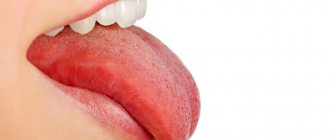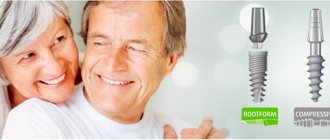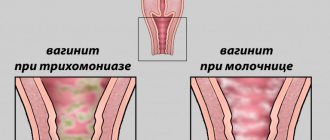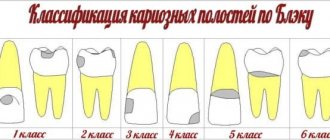Symptoms Causes Degrees of mobility Diagnostics Treatment methods Splinting Treatment at home Prevention
Normally, healthy teeth have little mobility due to the elasticity of the ligamentous apparatus and the need to absorb the chewing load. Physiological mobility is 0.06 - 0.15 mm, completely invisible to humans. Excessive mobility, noticeable when pressing on the tooth, is an anomaly that requires the intervention of a dentist. Even if a mobile tooth looks normal and does not hurt, loosening indicates a violation of the dentogingival connection, which is fraught with loss of a dental unit.
Pathological tooth mobility occurs due to various dental problems or injuries. What to do if a tooth is loose? Go to the dentist. Timely diagnosis and treatment will preserve the integrity of the dentition, restoring the functioning of the ligamentous apparatus. The treatment method is selected according to the severity of the defect, its location, and the presence of associated factors. After a comprehensive diagnosis, specialists from the RUTT clinic in Moscow will select treatment taking into account the clinical picture and indications for one or another method.
Symptoms
The main symptom is one - when you press on a tooth, it moves left and right or back and forth. Associated symptoms depend on the cause of mobility and may include:
- bad breath;
- redness, bleeding, swelling, soreness of the gums;
- abundant dental plaque;
- itching, burning gums;
- the tooth is loose and hurts when pressed;
- gum recession (exposure of the neck of the tooth);
- pathological abrasion of enamel;
- muscle hypertonicity;
- symptoms of intoxication - headache, fever, nausea, etc.
All causes are accompanied by corresponding symptoms - the tooth became loose after a characteristic crunch was heard, most likely we are talking about a longitudinal or scaly fracture of the root. A healthy tooth is loose - more often than not, this indicates an occlusal, mechanical injury. Several teeth in a row loosen at once - this is a manifestation of periodontal pathologies (periodontal disease, periodontitis).
What will the doctor do if the tooth is loose?
In modern dentistry, tooth-preserving methods are practiced, so a tooth is removed only if it is very loose and cannot be restored. When an adult’s teeth become loose, treatment depends on the causes and course of the pathological process.
If the loosening is still minor and is caused by weakening of the gums, it is necessary to clean the periodontal pockets from bacterial deposits. For this purpose, therapy is carried out using the Vector device. The doctor directs a healing mixture into the pockets, which acts simultaneously with ultrasonic vibrations and effectively cleanses the teeth down to the roots. The procedure is painless and promotes gum healing. Also, many dentists use lasers for the same purposes.
After this, the doctor prescribes therapeutic treatment:
- applications with antiseptic drugs;
- applying medicinal gels to the gums that relieve inflammation and restore tissue;
- strengthening gums with rinses - herbal infusions (aloe, oak bark);
- taking vitamins;
- gum massage, which needs to be performed 3-4 times a day on your own;
- if there is inflammation with purulent discharge, the dentist will recommend antibiotics.
In severe cases of periodontitis, when the gum pockets are deep (more than 7 mm), surgical intervention may be necessary - open curettage. During this procedure, the surgeon opens the gum, clears the pocket of infection, applies medication, and sutures the tissue.
Causes of tooth mobility
The roots of the teeth are located in the sockets (alveoli), they are firmly connected by the periodontium - a layer of connective tissue, collagen fibers, nerves and blood vessels. It is the periodontium that provides the necessary shock absorption of the dentition, allowing units to move in different planes, dampening chewing pressure. Periodontium is part of the periodontal tissues, such as gums, ligaments, cement, and bone surrounding the roots. If the connections between the alveolus, periodontium and tooth root are disrupted, the dental units begin to move beyond normal limits. The reasons for these changes are:
- inflammation and destructive changes in the periodontium (periodontitis, periodontal disease, periodontitis);
- dental diseases (flux, cyst, etc.);
- chronic systemic diseases (osteoporosis, diabetes mellitus, thyroid dysfunction and other diseases accompanied by metabolic, circulatory, and tissue regeneration disorders);
- malocclusion, uneven pressure on one tooth or group of elements (occlusal trauma);
- bruxism;
- jaw injury (bruise, fracture);
- prosthetics errors (incorrectly installed prostheses, implants);
- damage from solid food;
- large interdental spaces (teeth begin to shift towards the empty space);
- age-related changes (puberty, menopause, pregnancy and lactation, old age);
- bad habits;
- long-term use of certain medications.
Natural mobility associated with age occurs exclusively in children, when baby teeth are replaced by permanent teeth. If a molar tooth in an adult is loose, we are talking about pathology. The cause may be improper redistribution of chewing loads, disease, and not necessarily dental disease. Increased mobility may occur during orthodontic treatment. To eliminate it and stabilize the correction result, after removing braces or aligners, retention devices (retainers) are used.
Causes of bleeding gums
If you are interested in the mechanism of how poor hygiene and gum inflammation lead to bleeding, it looks like this.
Plaque and tartar bacteria produce a large number of toxins and various pathogens that trigger a chain of inflammatory reactions in the gums. In particular, this leads to increased permeability and fragility of capillaries (which is due to the fact that blood appears precisely when brushing teeth), as well as to swelling, redness or cyanosis of the gingival papillae. In parallel with this, the process of desquamation (squamation) of epithelial cells of the gum mucosa intensifies, which leads to thinning of the epithelium. The latter further reduces the resistance of gums weakened by inflammation to mechanical stress, for example, when brushing teeth or chewing hard food. Therefore, when together: 1) fragility and increased permeability of capillaries, 2) thinning of the epithelium + 3) even completely normal mechanical stress, it ends in bleeding when brushing your teeth.
By the way, a very common symptom that accompanies bleeding gums is pain when brushing your teeth. The mechanism of its development is also associated with thinning of the epithelium of the gum mucosa and a decrease in the latter’s resistance to mechanical stress. And the conclusion that needs to be drawn from all of the above is that treatment should not be tied to the fight against a separate symptom of bleeding; it should consist in eliminating the main cause of gum inflammation, i.e. removal of microbial plaque and tartar.
Degrees of mobility
- I
– the tooth deviates back and forth from neighboring units
by no more than 1 mm
, there are no symptoms from the periodontium or gums; - II
– amplitude of swing back and forth and sideways
by 1 mm or more
, tartar and plaques are visible on the enamel, redness, swelling, bleeding and soreness of the gums are possible; - III
– the teeth swing strongly in any direction with slight pressure with the tongue or chewing, the amplitude of the displacements
significantly exceeds 1 mm
; - IV
– the tooth shifts in all planes, rotates around its axis, and
barely stays
in the gum tissue.
Pathological mobility of any degree requires complex treatment. If the tooth is located in the gum, the periodontium and socket are intact, the process is reversible. Dental units begin to become very loose when periodontitis or periodontal disease is advanced. With deep periodontal damage, weakening and destruction of the ligamentous apparatus, bone atrophy, tooth extraction may be required, followed by implantation and prosthetics.
What diseases are bleeding gums a symptom of?
Bleeding gums can be either an independent disease or a symptom of another. There are three oral diseases that can lead to bleeding:
- Periodontal disease. With periodontal disease, it is not so much the gums that are damaged as the soft tissue around them. Due to the damage to these tissues, which dentists call periodontium, there is an increase in the amount of plaque on the teeth, which leads to microtrauma of the gums. With periodontal disease, tooth pockets do not form, and the gums themselves become inflamed quite rarely.
- Periodontitis. With periodontitis, both the gums and the soft tissue around them are damaged. The disease progresses very quickly. If left untreated, symptoms such as gradual destruction of the alveolar process, inflammation of the gums and soft tissues, formation of dental pockets (which often fester), and so on are observed. Periodontitis is relatively common.
- Gingivitis. Gingivitis causes damage to the gums. If gingivitis is not treated, it evolves into periodontitis.
Diagnostics
Diagnosis begins with collecting anamnesis. The dentist finds out when the tooth began to become very loose, whether this happened before, and what chronic diseases the patient has. Next, a dental examination of the oral cavity is carried out, the general condition of the dentition and periodontium is assessed. The degree of unsteadiness is assessed according to the subjective sensations of the patient and the dentist. The doctor checks the direction and magnitude of the deviation using tweezers:
- the instrument is applied to the upper part of the dental crown and moved in different directions;
- to identify vertical or circular displacement, the crown is clamped, carefully lifted up, and rotated.
Additionally, X-ray diagnostics are performed: orthopantomogram, CT scan, targeted X-ray to identify periodontal pathologies, injuries, and assess the depth of tissue damage. Based on the results obtained, effective treatment is selected. If mobility is due to a chronic disease, a specialized specialist (endocrinologist, therapist, rheumatologist, etc.) is involved in treatment. Why the lower teeth are loose, what is causing the mobility of the upper incisor - the doctor will be able to accurately answer these questions after a comprehensive dental examination.
Loose teeth - risk group
Loose teeth often occur in older people and pregnant women. In this case, this is a concomitant feature of the physical condition. To prevent loose teeth, older people and pregnant women need to consume dairy products (kefir, cottage cheese), more fruits, vegetables and berries. Make an appointment with a specialist doctor to prescribe calcium supplements.
Smokers are at particular risk for loose teeth. Harmful toxins released when smoking greatly weaken the protective functions of the gums. According to statistics, the teeth of smokers become loose twenty-five percent more often than the teeth of non-smokers.
Have you noticed that your tooth is loose? Do you feel an unpleasant taste of blood after eating solid foods? Contact your dentist immediately! If you are in the eastern district of Moscow, come to us! Your consultation with a doctor will be free of charge.
Treatment methods
The treatment regimen and the scope of medical manipulations are selected according to the patient’s somatic status. The inflammatory process is eliminated, professional oral hygiene is performed, and antimicrobial therapy is prescribed. Treatment of mobility is aimed at eliminating the underlying cause that led to the weakening of the ligamentous apparatus. If it is periodontal disease, then infection and inflammation are treated; in case of malocclusion, orthodontic treatment is carried out; in case of injury, a temporary splint is applied.
Treatment includes various methods, including grinding crowns, normalizing occlusion, splinting, and prosthetics.
- Thanks to bite correction, the load on the periodontium is normalized, the teeth occupy a more stable position in the sockets.
- Wearing a special mouthguard that prevents clenching or grinding of the teeth will help strengthen loose teeth in the gums during bruxism or clenching.
- In case of physiological changes, hormonal levels and nutrition are corrected, vitamin therapy is carried out, and the immune system is strengthened.
- In case of injury, a special device is installed on the dentition - a splint, which helps to fix loose units and correctly distribute the load between healthy and injured teeth.
In some cases, it is impossible to save a loose tooth. Direct indication for extraction
is mobility of 3-4 degrees with loss of bone tissue by 70%, atrophy of the jaw bone by more than 50% with damage to the dental pulp. In such situations, it is advisable to remove the loose tooth, preserving the bone tissue for subsequent implantation.
Antiseptics for rinsing
Mouth rinse
To rinse the mouth, you should take products with antibacterial and anti-inflammatory effects. In order to enhance overall healing, they are usually used as a supplement.
So, what do dentists recommend:
- Miramistin 0.01%. The drug is especially effective for herpes infections, has a calming and antimicrobial effect.
- Stomatophyte – contains medicinal herbs and alcohol. Recommended for use in the development of gingivitis and periodontal disease.
- Polyminerol – stops bleeding, accelerates regeneration processes.
- Chlorhexidine, concentration not more than 0.05%. This is an antibacterial agent used for inflammatory processes. In addition, dentists recommend rinsing your mouth with it after tooth extraction.
- Chlorophyllipt is based on an extract of eucalyptus leaves. It is prescribed when the oral cavity is affected by pathogenic staphylococci.
- Maraslavin. Contains wormwood herb, savory, black pepper. Helps relieve pain, eliminates allergy symptoms.
- Periodonticide. It contains a large number of medicinal herbs, due to this it has a good anti-inflammatory effect.
To achieve the desired result, rinses should be used in a course. Moreover, one product cannot be used for more than a month. The thing is that many bacteria can develop resistance.
Splinting teeth
The method is aimed at strengthening the teeth in the gums and preventing their further loosening. The essence of the manipulation is to combine mobile units into one block with healthy ones using a special fixing structure. Splinting can be temporary ( up to 1-3 months
), long-term (
up to 1 year
), permanent. Tires are divided into:
- removable
– mouthguards, clasp dentures; - non-removable
- tape, fiberglass or aramid thread, crowns, pin inlays (intradental splints), cap splints.
An effective option is fiberglass splinting
, aesthetic nanomaterials or ceramics. A strong, translucent white tape or thread is fixed to the inner surface of the teeth using a light-curing composite. The material is biocompatible with the human body, does not absorb saliva, does not enter into chemical reactions, firmly adheres to the enamel, and reliably holds the units in the desired position.
With temporary splinting, the structure is fixed for several months. This option is used for mild forms of periodontitis, periodontitis, to consolidate the result of orthodontic correction or mobility caused by injury. A permanent splint is installed in the treatment of moderate periodontitis, the presence of voids in the row (removed or fallen units). The fixing structure is replaced with a new one every 4-5 years
, sometimes more often (according to indications).
Splinting clasp prosthesis
Clasp prosthesis
– metal base (arch) with plastic gum and artificial crowns. Since the design has an attachment for each dental unit, the prosthesis can replace several lost teeth while simultaneously splinting loose elements. This method is used in the treatment of pathologies of moderate severity, when in addition to movable units there are healthy ones that serve as support for the prosthesis.
Splinting with crowns
The teeth are depulped, the root canals are filled, ground, and crowns made of durable material (metal-ceramics, ceramics, etc.) “soldered” to each other are fixed on them. This method is characterized by high reliability and long service life. The elements under the crowns are firmly locked together and completely motionless.
Treatment at the dentist's office
Treatment of bleeding gums when brushing teeth includes removing plaque from enamel and tartar and rinsing deep periodontal pockets for periodontitis and periodontal disease. These manipulations are carried out by a specialist in the clinic’s office.
To remove dental plaque, ultrasonic cleaning is used, less often - the use of instruments and mechanical cleaning of the enamel. The number of sessions required depends on the complexity of the work and the amount of deposits.
Washing of periodontal pockets is carried out in chronic forms of periodontitis and periodontal disease. It helps remove pathogenic microbes, their waste products, pus and exudate. The solutions used have antibacterial, antimicrobial and anti-inflammatory effects.
Adjuvant therapy
The main treatment involves auxiliary therapy aimed at preventing further loosening of the teeth. It includes:
- prescription of anti-inflammatory drugs, vitamins, biostimulants;
- ointments, gels to strengthen gums;
- antibiotic therapy;
- systematic professional teeth cleaning;
- physiotherapy (electrophoresis, plasma lifting, etc.);
- gum massage
If the front tooth becomes loose after an impact or several lower units become mobile due to bleeding gums, treatment should begin as quickly as possible. Complex therapy in the early stages around the moving element will help to form healthy tissue, ensuring reliable retention of the tooth in the gum. In complex, advanced cases, with 4 degrees of mobility, removal followed by prosthetics is advisable.
Factors predisposing to bleeding gums
If this is not the first time that you have experienced bleeding, this indicates that your gum inflammation is chronic and has been going on for quite a long time. In this case, when brushing your teeth, blood may appear and then disappear again (24stoma.ru). Typically, gums bleed only during exacerbations of chronic inflammation. Exacerbation of the inflammatory process most often occurs in the off-season and is associated with a decrease in immunity or the development of vitamin deficiency.
But we don’t want you to think that poor immunity or vitamin deficiency are the causes of exacerbations of gum inflammation and bleeding. The cause is still plaque bacteria. It’s just that local protective factors in the oral cavity (against the background of decreased immunity) no longer cope with the previous volume of toxins and pathogens released by microbial plaque on your teeth. Other predisposing factors may include mouth breathing and xerostomia, which contribute to an increase in the amount of plaque in the mouth.
Prevention
To prevent tooth mobility, you must maintain careful oral hygiene and use brushes and pastes recommended by your doctor. Don’t forget to floss, irrigate, and rinse your mouth after eating. Regular visits to the dentist (every 6 months) for a preventive examination and professional cleaning will help identify pathology at the initial stage, avoid complications, and maintain a healthy smile.
Author of the article Voznyuk Vladimir Aleksandrovich Maxillofacial surgeon-implantologist of the highest category
Work experience: 28 years.
Dentist advice
Doctors emphasize that you need to carefully take care of your oral health and brush your teeth in a timely manner. A high level of hygiene is the basis without which nothing can be achieved at all. If plaque is not removed in a timely manner, thinned enamel, loosening of the molar units, hyperesthesia, and gingivitis will not take long to occur.
At the same time, it is not enough to just brush your teeth in the morning and evening - you need to do it correctly. During the procedure, you should use a high-quality brush and paste (it’s good if your dentist selects them).
To the aid of sensitive and caries-prone units come:
- rinses with anti-inflammatory activity;
- strengthening gels;
- floss;
- professional hygiene.
Pastes and gels
At home, a person can strengthen enamel by using high-quality dental pastes and gels. Particularly valuable are compositions that include the following components:
- Fluorine. It is better absorbed when presented in the form of sodium fluoride or amino fluoride. Passing through the outer layers of enamel, these components react with hydroxyapatite, the main substance that makes up the upper shell of the tooth. As a result, a strong connection is formed that is not susceptible to the negative effects of bacteria and acids that cause caries. On an ongoing basis, a person can use products containing 1000 ppm of fluoride. If the doctor has prescribed a treatment course for weakened enamel, this indicator can be increased to 1500 ppm. In this case, the drug will also exhibit remineralizing properties. But it is suitable only for course use. If the packaging says that fluoride contains more than 1000 ppm, you should not use the product without consulting a doctor. Such amateur activities often result in fluorosis, a very unpleasant dental disease associated with an excess of fluoride in the body.
- Hydroxyapatite. An excellent remineralizing component. Helps to qualitatively strengthen dental tissues at home. It quickly integrates into the crystal lattice of hard tissues. Even eliminates caries at the spot stage. The compound fills all the small cracks and makes the crown part absolutely smooth, resistant to the destructive effects of bacteria and microbes.
- Amorphous calcium phosphate, glycerophosphate. These substances have the unique ability to form a kind of protective film on the surface being treated. It strengthens the enamel and protects the unit from the destructive influence of harmful factors. It is important to know that these two components are contraindicated for people who are allergic to milk protein.
Natural plant extracts. There are a lot of pastes with plant extracts on sale. Natural ingredients such as propolis, chamomile, sage, lavender, yarrow, and oak bark have proven themselves to be excellent. Of course, they are not as effective as the above-mentioned chemical components. But they have a good effect on the condition of the gums, relieve increased bleeding and provide reliable prevention of gingivitis.
If you are looking for something to strengthen your teeth, then start with professional hygiene. This procedure will prepare the dentition for further activities. Immediately after hygiene, ask your doctor what products he will recommend for you. This approach to therapy is the most effective and completely safe.










